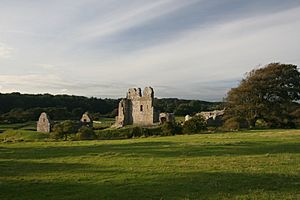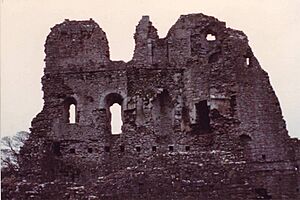Ogmore Castle facts for kids
Ogmore Castle (which is Castell Ogwr in Welsh) is a very old castle ruin in South Wales. It's a Grade I listed building, meaning it's super important! You can find it near the village of Ogmore-by-Sea, just south of Bridgend. The castle sits right by the River Ewenny and the River Ogmore.
Building this castle might have started way back in 1106. Ogmore was one of three castles built in this area in the early 1100s. The other two were Coity Castle and Newcastle Castle. Ogmore Castle was used for a long time, even until the 1800s! It was a court, a prison, and more. Now, it's a cool set of ruins and a famous local spot. Local groups take care of it today.
Contents
What's in a Name?
When a writer named John Leland wrote about his travels, he called this fortress "Ogor Castelle." The name comes from the nearby River Ogmore, which is called Afon Ogwr in Welsh. So, the castle is named after the river!
A Look Back: Castle History
Building Ogmore Castle might have begun around 1106. This was even before the famous Norman conquest was fully settled. A historian named Caradoc of Llancarfan wrote that Robert Fitzhamon, a Norman leader, gave the castle and land to William de Londres. William was one of the legendary Twelve Knights of Glamorgan.
In 1116, William de Londres had to leave the castle because Welsh warriors appeared in large numbers. His butler, Arnold, bravely protected the castle from the Welsh attack while William was away. For his courage, Arnold was made a knight, becoming Sir Arnold Butler. He also received the castle and land of Dunraven as a reward.
It was common back then for powerful people to build religious places. William de Londres, or his son John, built Ewenny Abbey about 1 mile (1.6 km) from the castle. Another religious spot, Ewenny Priory, was added near Ogmore Castle in 1141. It's about 2 miles (3.2 km) away. Later, the castle and its lands became part of the Duchy of Lancaster in 1298. This means it has been owned by the royal family for a very long time, even to this day!
Castle Design and Buildings
The castle started with big, steep earthworks shaped like an oval. This area was about 164 feet (50 meters) long and 115 feet (35 meters) wide. Inside, the main area was flat and had buildings made of wood. Later, stone was used for building. The windows were round and made with special Sutton stone. The main hall on the first floor even had a fancy fireplace!
William's son, Maurice, is believed to have built the tall, rectangular keep. This might be the oldest Norman keep in Glamorgan. The keep was the first stone building at the castle, probably built around the 1120s. It's the tallest part of the castle still standing and one of the oldest buildings in all of South Wales! Even though only three of its original walls are left, you can see they were built with different shaped stones and pebbles. Around 1200, Thomas de Londres replaced the wooden fence around the castle with a strong stone wall.
In the early 1200s, a second floor was added to the castle. This floor had private rooms. There were also special toilets called Garderobes on two levels. A latrine tower was built on the outside. A well-preserved lime kiln was also built over an older structure. Later, a courthouse was built in the 1300s and rebuilt in the mid-1400s. This building was rectangular with a simple door and two rooms next to it. After being damaged during Owain Glyndŵr's revolt, a new courthouse was built in 1454. It was used until at least 1631.
Today, you can still see the keep and some of the outer walls of the castle.
Exploring the Castle Grounds
A deep, rock-cut ditch surrounded the castle. This ditch was usually dry, but it would fill with water when the River Ewenny flooded during high tide. Even when the ditch filled, a special stone wall kept the water from flooding the inside of the castle.
If you look towards the sea from the castle ruins, you can see big sandhills stretching almost to the town of Briton Ferry. Across from Ogmore Castle is a place called Merthyr Mawr. You can find two carved crosses there. You can reach this village by following a footpath from the castle.
Close to the castle, there are also famous stepping stones across the river. These stones are a Scheduled Ancient Monument, meaning they are protected because they are so important. A little further southeast, there are some shallow pools of water that are said to have appeared suddenly. One of them is perfectly round, about 7 feet (2.1 meters) across.
The White Lady of Ogmore Castle
There's a famous ghost story about Ogmore Castle! People say a ghost called Y Ladi Wen (which means "the White Lady" in Welsh) guards a hidden treasure at the castle.
The story goes that this spirit wandered the area for a long time. Finally, a brave man dared to approach her. When he did, the spirit led him to a treasure hidden under a heavy stone inside the old castle tower. It was a cauldron full of gold! The spirit let the man take half the treasure for himself. But the man was greedy. He came back later and took even more of the treasure. This made the spirit very angry! Her fingers turned into claws, and she attacked the man as he walked home. The man became very sick. He only died after he confessed how greedy he had been. After that, people said that an illness called Y Ladi Wen's revenge would happen to anyone who died without telling where their hidden treasure was.
The stories about the White Lady at the castle are probably linked to an old belief. People used to think that the River Ogmore itself held the spirits of those who died without telling where their treasures were hidden. The tradition says these spirits can only rest if their treasures are found and thrown downstream into the river. Throwing treasures upstream would not help the spirits find peace!




